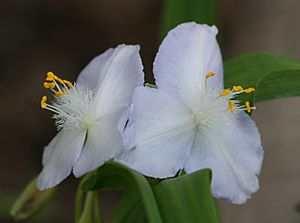Ozark spiderwort facts for kids
Quick facts for kids Ozark spiderwort |
|
|---|---|
 |
|
| Inflorescence of Tradescantia ozarkana in Osage, Caroll County, Arkansas | |
| Conservation status | |
| Scientific classification | |
| Genus: |
Tradescantia
|
| Species: |
ozarkana
|
Tradescantia ozarkana, also known as the Ozark spiderwort, is a type of plant. It belongs to the Tradescantia family, which includes many kinds of spiderworts. This plant grows naturally in the central United States, specifically in Missouri, Arkansas, and Oklahoma. You can often find its beautiful flowers blooming from April to May in rocky areas, like woods and along bluff ledges.
Contents
What is the Ozark Spiderwort?
How Does it Look?
The Ozark spiderwort has stems that can grow taller than 50 centimeters (about 20 inches). These stems grow from thick roots. They are usually smooth, but sometimes they can be a bit hairy. The stems often have a waxy, bluish-white coating and feel a little fleshy, like a succulent plant.
Its leaves grow up to 30 centimeters (about 12 inches) long and about 4 centimeters (about 1.5 inches) wide. They wrap around the stem at their base. The leaves are smooth and have a waxy coating on both sides, though it's less noticeable on the top. Their edges have tiny hairs, and their shape is long and narrow, like a spearhead.
The Flowers of Ozark Spiderwort
The flowers grow in clusters at the top of the stem. Each flower has a stalk, called a pedicel, which is about 3 centimeters long. These stalks are covered in tiny, sticky hairs and bend strongly after the fruit forms.
The flowers have three petals that can be white, pink, or light purple. These petals are smooth and broadly oval-shaped, about 2 centimeters long. They form clear, distinct shapes. Each flower has six stamens, which are the parts that produce pollen. The white filaments (stalks of the stamens) are about 3 millimeters long. They have many tiny hairs, especially on their lower half. The yellow anthers (where pollen is held) are about 2 millimeters wide and 1 millimeter long.
The flower has one smooth style, which is 2 to 3 millimeters long. The ovaries (where seeds develop) have three sections, with one ovule (future seed) in each section. The top of the ovaries has upright, gland-tipped hairs. The flowers also have three sepals, which are like small leaves protecting the bud. These sepals are oval-shaped, pointed, and have sticky hairs on the outside, but are smooth on the inside. They are about 8 millimeters long and 4 millimeters wide.
Family Tree of the Spiderwort
Scientists study the chloroplast DNA of plants to understand how different species are related. For the Ozark spiderwort, studies on its DNA show that it is closely related to other Tradescantia species that grow upright in North America. This helps us understand its place in the larger plant family.


